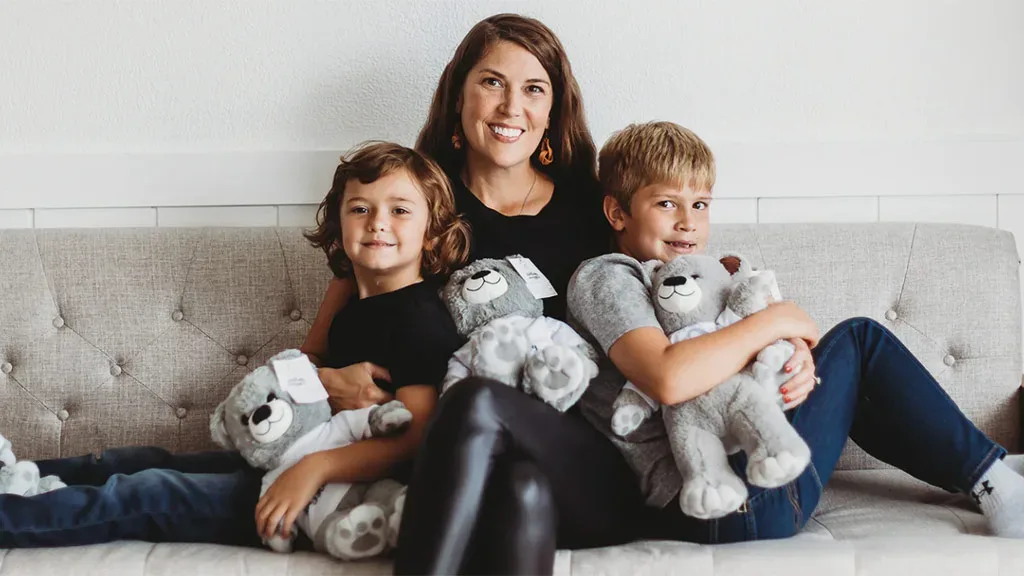Mental health is an important part of all of our lives. And yet, it is often overlooked as a crucial component in an employee’s well-being in the workplace.
Luckily, many companies are beginning to recognize the importance of mental health. Some have even taken steps to address it by implementing employee wellness programs, offering mental health benefits, or promoting a culture of support around mental health. But there is still work to be done.
In this interview, two Women in Toys, Licensing & Entertainment (WiT) members — Lindsey Berger, Director of New Business Development at License 2 Play Toys and Dr. Erica Gergely (pictured top), a Licensed Clinical Psychologist and the Inventor of the Soothing Snuggler — discuss the benefits of prioritizing mental health in the workplace and share some advice on how organizations can be more supportive.
WiT: Globally, there seems to be a shift in mental health where we’re starting to see more opportunities for conversation in the workplace – do you agree?
Dr. Erica Gergely: Yes, absolutely. The pandemic illuminated the obvious — and undiscussed — reality that mental health is important in every facet of life, including our work. Consequently, we’re now seeing the mental health needs of employees as a top priority in many organizations. Employee mental health is directly related to job performance, innovative behavior, and work engagement.

WiT: How have the organizations you’ve worked for supported mental health and wellness?
Lindsey Berger: When I worked for Melissa & Doug, the organization implemented a number of initiatives to promote mental well-being:
- The company launched a mental health affinity group that hosted quarterly activities for employees to help promote positive mental health. Some examples include toy trivia, an in-office massage event, and an open-share forum.
- “Sick days” were changed to “wellness days” in corporate documents to encourage employees to use their days to better care for themselves.
- The executive team made it a point to encourage employees to use all available PTO/wellness days to recharge and reset. There were even Town Hall announcements to highlight the number of PTO/wellness days still available within the company.
WiT: Kids are also facing mental health challenges. How can the toy industry support the well-being of youth, both in school and at home?
DEG: The pandemic challenged early childhood development, with various prenatal and postnatal effects. Kids learn through play. That’s why I see the toy and game industry as uniquely positioned to create the vital tools necessary to facilitate healing, growth, and assistance in gaining lost ground in the mental, emotional, and social health of kids. With endless learning potential through play, I believe we can help bridge the developmental gaps both at home and in educational settings.
LB: The toy industry has a responsibility to the kids of today and tomorrow to supply diverse and inclusive toys. Manufacturers are promoting inclusivity and well-being by thinking globally and providing toys that resonate with kids regardless of race, gender, or ethnicity. They’re also incorporating multi-language packaging and implementing sustainability initiatives to create a better world. Products on store shelves now come in various skin tones and can be adapted for kids with alternative needs.
WiT: WiT is a conduit for human resources professionals and other decision-makers in establishing mental health practices within companies. What are your recommendations for leaders who want to promote positive mental health in the workplace?
DEG: Incorporating mental health education and training into the workplace is critical. Leaders who have direct relationships with employees can model good behavior around mental health and wellness, and they’re often the first to know when a team member may need help. They should be trained in recognizing the warning signs and in knowing how to engage with and support someone who may be struggling with their mental health. I also highly recommend that leaders are well-versed in their company’s available mental health benefits and resources and that they regularly communicate offerings with employees.
LB: I would highly recommend launching affinity groups to create an inclusive corporate culture. Affinity groups allow employees to connect and share common interests, which improves positive mental health in the workplace. It is also key that corporate leaders from the top-down encourage employees to take PTO to avoid burnout. Mental health and physical health are closely connected and can impact employee performance.
A version of this article was originally published in the 2023 Classics & Specialty Issue of The Toy Book. Click here to read the full issue! Want to receive The Toy Book in print? Click here for subscription options!

